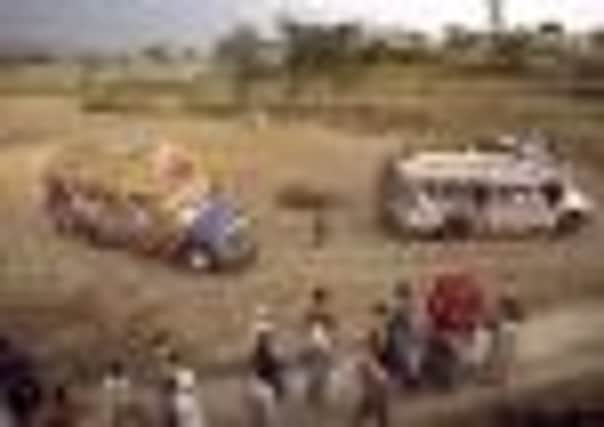Highway of dreams leads from Asia to Yorkshire


Rudyard Kipling immortalised it in his novel Kim as ‘‘such a river of life as nowhere else exists in the world’’ and it was used by the British to conquer India.
Now the secret history of the Grand Trunk Road the oldest, longest, and most famous highway in southern Asia and its surprising links with many towns and cities in Yorkshire have been laid bare by two writers – Tim Smith, a freelance photojournalist, and anthropologist Irna Qureshi.
Advertisement
Hide AdAdvertisement
Hide AdTheir 120-page book filled with glorious pictures, explores its history, showing why it was so crucial to the process of migration to Britain and how the close links between Britain and places along it continue to this day.


Using personal stories gathered by Ms Qureshi and photographs and texts by Mr Smith this book tells, for the first time, the story of the profound impact of the British on Grand Trunk Road and its people, and how they in turn have irrevocably altered the fabric of modern day Britain.
The road was also used by its residents to begin journeys that ended all over the world, and from the days of the British Raj onwards large numbers of them have settled in Britain.
Between Delhi and the Khyber Pass, the Grand Trunk Road travels through the homelands of over 90 per cent of British Pakistanis, as well as the vast majority of British Sikhs and Hindus from the Indian Punjab.
Advertisement
Hide AdAdvertisement
Hide AdMr Smith, 51, of Shipley, Bradford, said the idea originated out of his work with Asian communities in Bradford, Leeds and Birmingham.


He said: ‘‘What I came to realise was when you asked people where their families originally came from almost all of them mentioned a town or village along the Grand Trunk Road.
‘‘It puzzled me why this should be so, I did some research but there didn’t seem to be much to go on so I decided to find out for myself after hooking up with Irna who I knew through similar community projects.
‘‘She and I persuaded the People’s History Museum in Manchester and Bradford Industrial Museum to help fund a four week trip of around 500 miles covering Delhi to the Khyber Pass. So off we went in early 2007 to try to solve the mystery of what it was about this road that was so important.
Advertisement
Hide AdAdvertisement
Hide Ad‘‘The road itself is full of contradictions. On the one hand it is mucky, dusty and dangerous – health and safety is not a priority over there – and on the other there is this great kind of romance about it with decorated trucks stretching along it and a history that goes back to Alexander the Great and the Moguls.
‘‘Some people over there thought my puzzle was a bit daft and others said it was obvious. The British Army had set up lots of recruiting stations along the road and many young men simply walked down to them and were duly recruited.’’
Mr Smith said he experienced some fairly surreal moments during the trip. ‘‘You would be seemingly in the middle of nowhere on the Afghanistan border and out of the blue you would hear these Birmingham and Yorkshire accents and you would find yourself talking to people from Huddersfield and Bradford. I even met some people from Bradford who I knew over there.’’
For millennia the Grand Trunk Road was used by invaders to conquer the subcontinent.
Advertisement
Hide AdAdvertisement
Hide AdAnd for several centuries, it has linked the eastern and western regions of the Indian subcontinent, running from Bangladesh, across north India, into Peshawar in Pakistan up to Kabul, Afghanistan.
It was initiated by Chandra Gupta Maurya, and later renovated and extended by the famous Pashtun ruler Sher Shah Suri.
Over the centuries, the road, which was one of the most important trade routes in the region, facilitated both travel and postal communication.
The road was well planned, with milestones along the whole stretch.
Advertisement
Hide AdAdvertisement
Hide AdAfter the British arrived in 17th century they used it as the main artery of their conquest and rule of northern areas of British India.
Kipling describes it in Kim: “And now we come to the Big Road. the Great Road which is the backbone of all Hind…Truly the Grand Trunk Road is a wonderful spectacle.
‘‘It runs straight, bearing without crowding India’s traffic for fifteen hundred miles– such a river of life as nowhere else exists in the world.”
From tomorrow to March 26 an exhibition of photos from the book is on at the Pop Up Art Space, Centenary Square, Bradford. Opening times: Tuesday to Friday, 10am -6pm. Saturdays, 10am-5pm. There is a book launch and illustrated talk tonight at 6pm. The book is published by Dewi Lewis Publishing.
From Bangladesh to Kabul...
Advertisement
Hide AdAdvertisement
Hide AdFrom its origin at Sonargaon in the Narayanganj District of central Bangladesh, the Grand Trunk Road reaches India, passing through Kolkata, Bardhaman, Durgapur, Asansol, Dhanbad, Aurangabad, Dehri-on-sone, Sasaram, Mohania, Varanasi, Allahabad, Kanpur, Aligarh, Etah, Ghaziabad, Delhi, Karnal, Ambala, Ludhiana, Jalandhar, Amritsar. From the Pakistan border the Grand Trunk Road (part of the N-5) continues north through Lahore, Gujranwala, Gujrat, Jhelum, Rawalpindi, Attock District, Nowshera, Peshawar and Landi Kotal. It then enters Afghanistan and continues East through Jalalabad, Surobi and ends at Kabul.